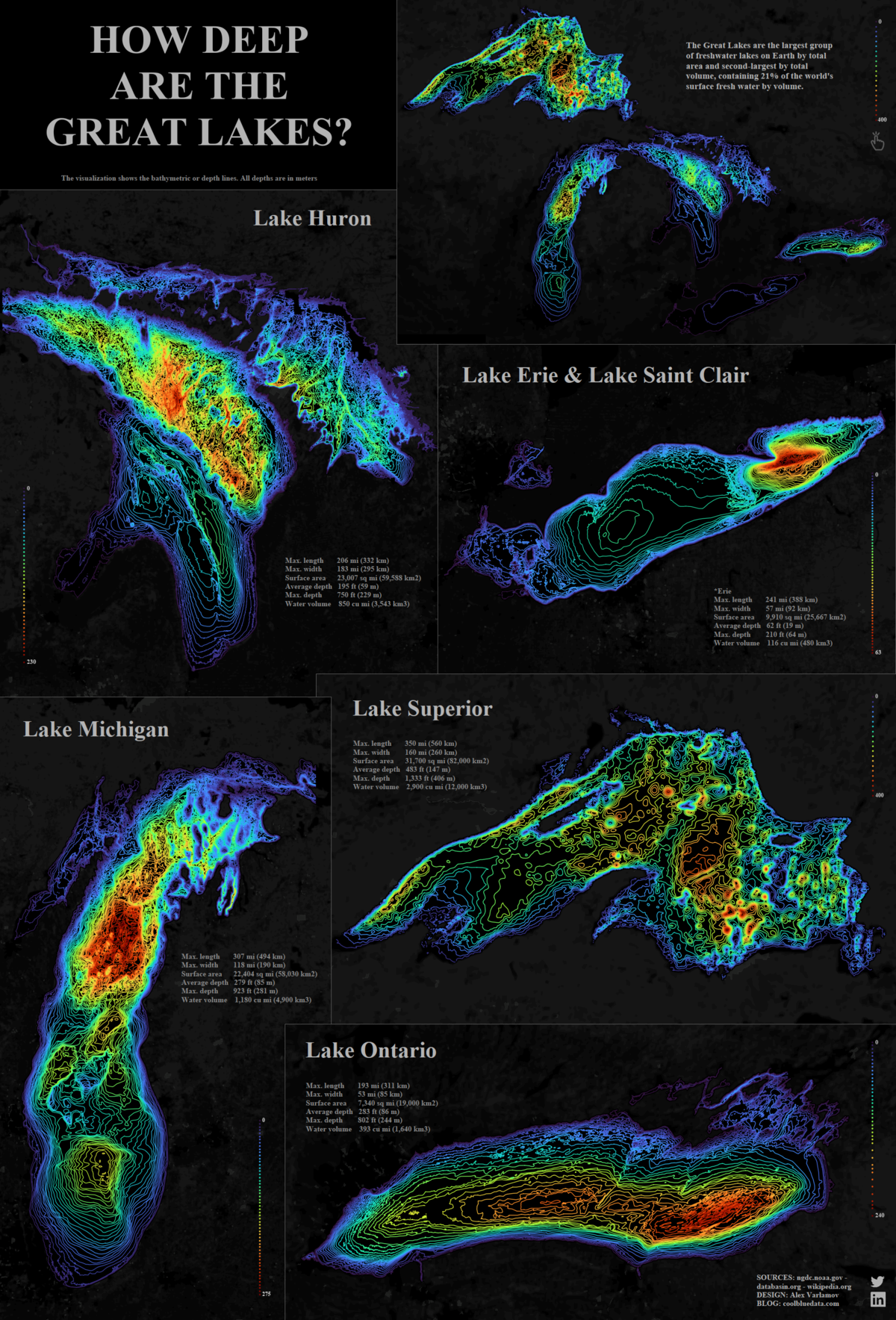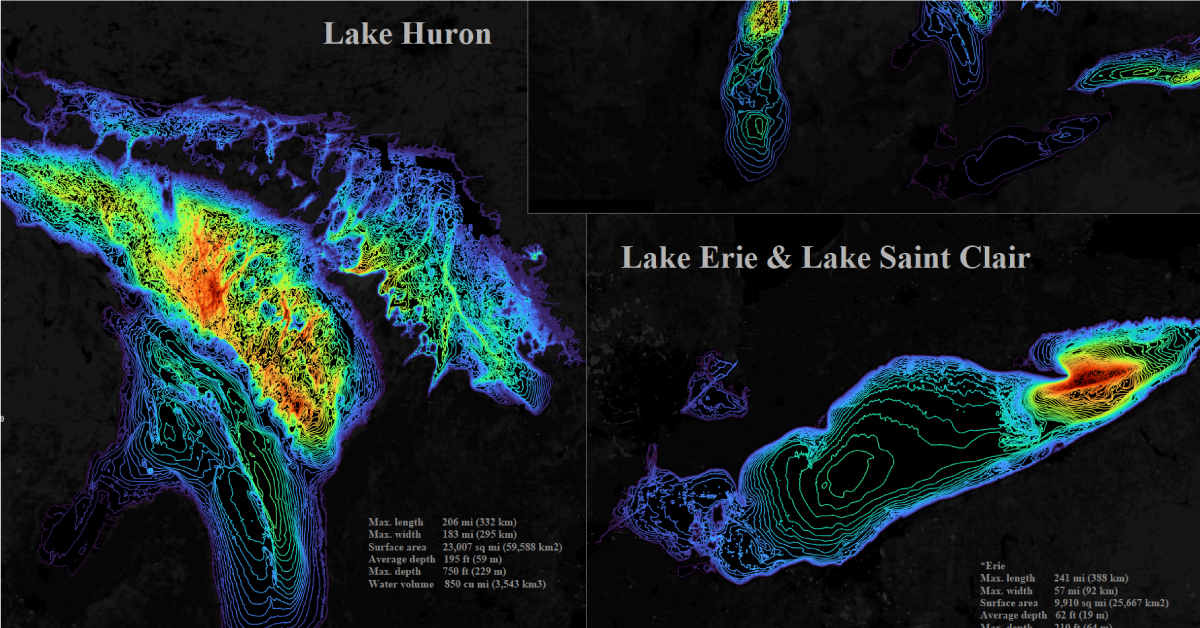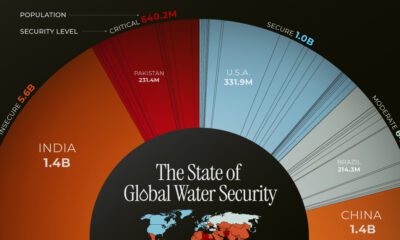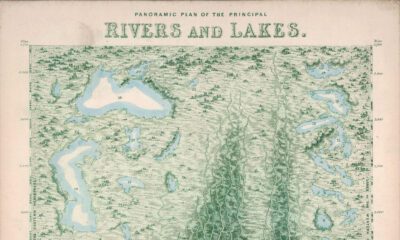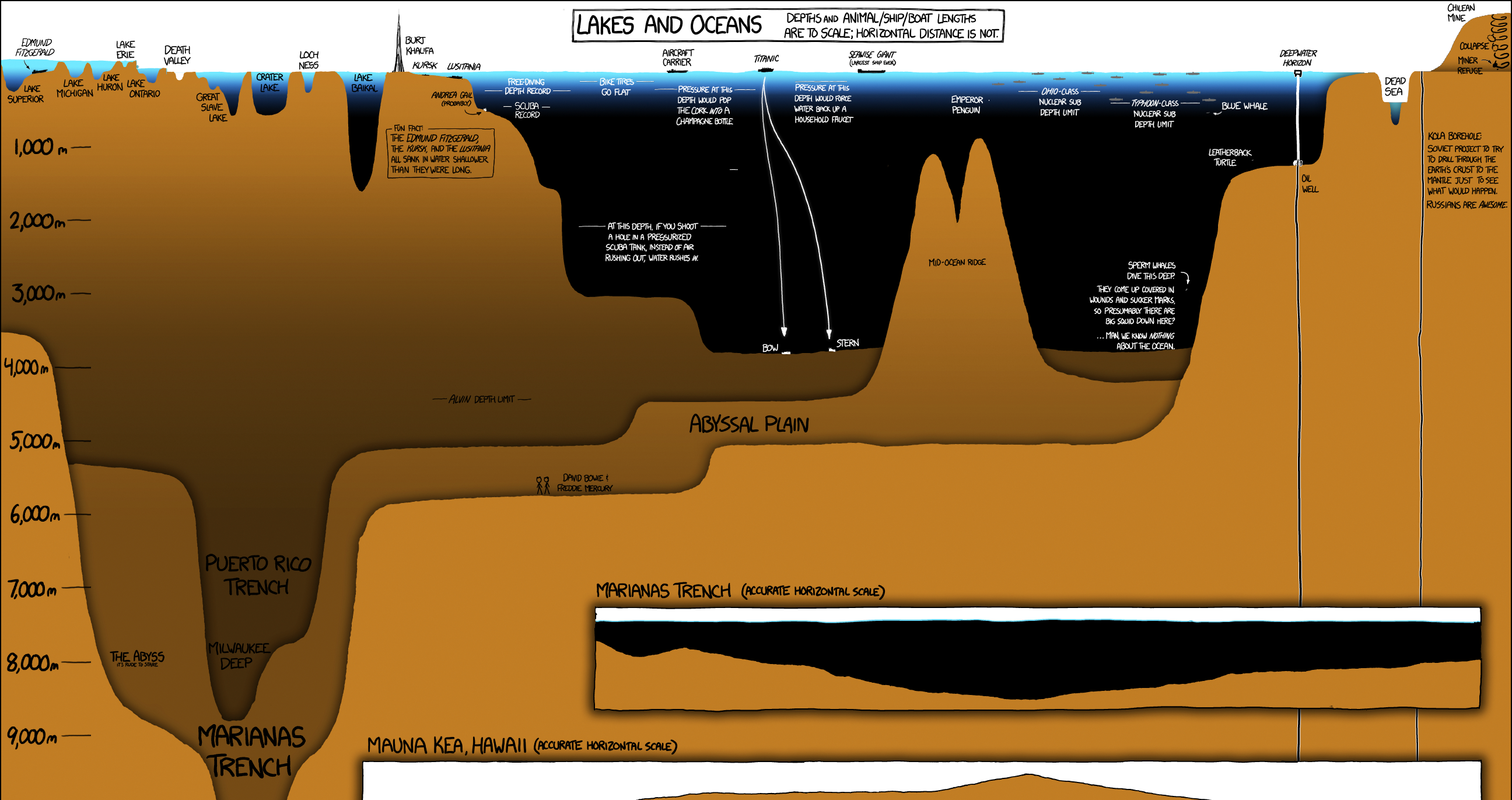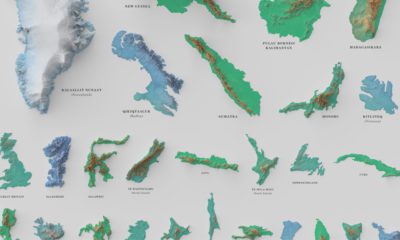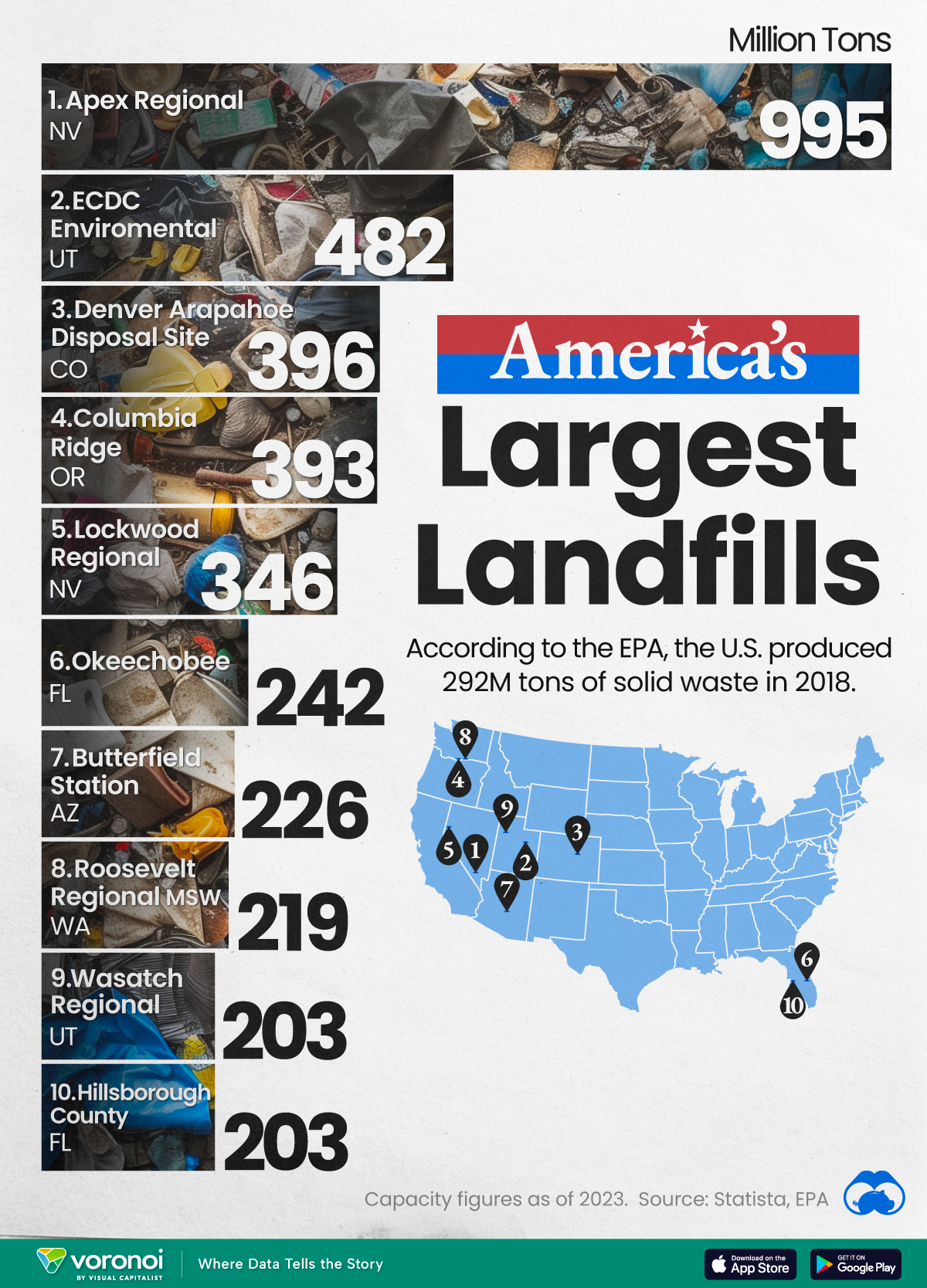Misc
Visualizing the Depth of the Great Lakes
View the full-resolution version of this infographic
Visualized: The Depth of The Great Lakes
Click here to view the interactive version of the visualization on Tableau.
As the seasons change, it’s natural to want to enjoy the outdoors to the fullest. The Great Lakes, a distinct geographical region sandwiched between the U.S. and Canada, provides immense opportunity for millions of tourists to do just that every year.
But did you know that altogether the Great Lakes contain 21% of the world’s surface freshwater by volume—or 84% of the surface freshwater in North America?
This bathymetric visualization, created by Alex Varlamov, helps put the sheer size and depth of all five of the Great Lakes into perspective.
What is Bathymetry?
Bathymetry is the study of the underwater depth of ocean or lake floors, a geographical science that falls under the wider umbrella of hydrography.
In essence, it is the underwater equivalent of topography. Contour lines help to represent and study the physical features of bodies of water, from oceans to lakes.
Most bathymetric studies are conducted via sonar systems, transmitting pulses that ‘ping’ off the ocean and lake floor, uncovering what lies below.
The Depth of the Great Lakes, Compared
High on the list of the world’s largest lakes, the five Great Lakes altogether account for over 244,700 km² (94,250 mi²) in total surface area. That’s bigger than the entire United Kingdom.
Lake Superior emerges, well, superior in terms of total surface area, water volume, and both average and maximum depth.
| Surface area | Water volume | Average depth | Maximum depth | |
|---|---|---|---|---|
| Lake Ontario | 19,000 km² (7,340 mi²) | 1,640 km³ (393 mi³) | 86 m (283 ft) | 245 m (804 ft) |
| Lake Erie | 25,700 km² (9,910 mi²) | 480 km³ (116 mi³) | 19 m (62 ft) | 64 m (210 ft) |
| Lake Michigan | 58,000 km² (22,300 mi²) | 4,900 km³ (1,180 mi³) | 85 m (279 ft) | 282 m (925 ft) |
| Lake Huron | 60,000 km² (23,000 mi²) | 3,500 km³ (850 mi³) | 59 m (195 ft) | 228 m (748 ft) |
| Lake Superior | 82,000 km² (31,700 mi²) | 12,000 km³ (2,900 mi³) | 147 m (483 ft) | 406 m (1,333 ft) |
Lake Erie is by far the shallowest of the lakes, with an average depth of just 19 meters (62 ft). That means on average, Lake Superior is about eight times deeper.
With that in mind, one drawback of the visualization is that it doesn’t provide an accurate view of how deep these lakes are in relation to one another.
For that, check out this additional visualization also created by Alex Varlamov, which is scaled to the same 20 meter step—in this view, Lake Erie practically disappears.
More than Meets the Eye
The Great Lakes are not only notable for their form, but also their function—they’re a crucial waterway contributing to the economy of the area, supporting over 50 million jobs and contributing $6 trillion to gross domestic product (GDP).
Together, the five Great Lakes feed into the Atlantic Ocean—and when we expand the scope to compare these lakes to vast oceans, trenches, and drill holes, the depth of the Great Lakes barely scratches the surface.
Maps
Map: Where Are America’s Largest Landfills?
According to the EPA, the U.S. produced 292 million tons of solid waste in 2018, of which 150 million headed to some of the largest landfills in the country.

Map: Where Are America’s Largest Landfills?
This was originally posted on our Voronoi app. Download the app for free on Apple or Android and discover incredible data-driven charts from a variety of trusted sources.
We map out America’s largest landfills, based on their total capacity (measured in millions of tons) for solid waste. Data for this graphic is sourced from Statista and is current up to 2023.
According to the EPA, the U.S. produced 292 million tons of solid waste in 2018. Of that, about 150 million tons headed to the country’s landfills. It would take more than 600 of the largest cargo ships (by dead weight tonnage) to move this much material at once.
Ranked: America’s Largest Landfills
Opened in 1993 and located 25 minutes from Las Vegas, Apex Landfill is believed to be one of the world’s largest landfills by both area and volume.
It spans 1,900 acres, or roughly the size of 1,400 football fields. Given its vast capacity, the landfill is expected to be able to accept waste for over 250 years.
Here are the top 10 largest landfills in the country.
| Rank | U.S. Landfill | State | Capacity (Million Tons) |
|---|---|---|---|
| 1 | Apex Regional | Nevada | 995 |
| 2 | ECDC Environmental | Utah | 482 |
| 3 | Denver Arapahoe Disposal Site | Colorado | 396 |
| 4 | Columbia Ridge | Oregon | 393 |
| 5 | Lockwood Regional | Nevada | 346 |
| 6 | Okeechobee | Florida | 242 |
| 7 | Butterfield Station | Arizona | 226 |
| 8 | Roosevelt Regional MSW | Washington | 219 |
| 9 | Wasatch Regional | Utah | 203 |
| 10 | Hillsborough County | Florida | 203 |
In a 2021 PBS interview, a spokesperson for Apex Landfill reported that the facility captured and treated enough landfill gas to power nearly 11,000 homes in Southern Nevada.
In fact, landfills can create electricity through a process called landfill gas (LFG) recovery. When organic waste decomposes, it produces methane gas which can be captured and purified to create fuel for generators.
As it happens, methane gas from landfills is the third-largest source of human-related carbon emissions, equivalent to 24 million gas passenger vehicles driven for one year. Its capture and treatment is a significant opportunity to combat emissions.
-

 China2 weeks ago
China2 weeks agoWhich Countries Have the Most Economic Influence in Southeast Asia?
-

 Brands2 weeks ago
Brands2 weeks agoHow Popular Snack Brand Logos Have Changed
-

 War2 weeks ago
War2 weeks agoVisualized: Aircraft Carriers by Country
-
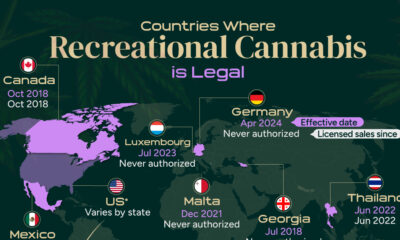
 Cannabis2 weeks ago
Cannabis2 weeks agoMapped: Countries Where Recreational Cannabis is Legal
-

 Culture2 weeks ago
Culture2 weeks agoCharted: How the Logos of Select Fashion Brands Have Evolved
-
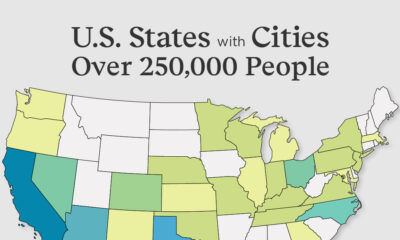
 population2 weeks ago
population2 weeks agoMapped: U.S. States By Number of Cities Over 250,000 Residents
-

 Crime2 weeks ago
Crime2 weeks agoVisualizing Global Losses from Financial Scams
-
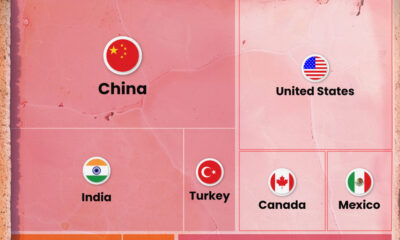
 Mining2 weeks ago
Mining2 weeks agoThe Biggest Salt Producing Countries in 2023

